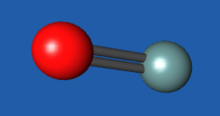
| |
| Names | |
|---|---|
| IUPAC name germanium(II) oxide | |
| Other names germanous oxide | |
| Identifiers | |
| CAS Number | |
| 3D model (JSmol) | |
| ChemSpider | |
| ECHA InfoCard | 100.039.914 |
| PubChem CID | |
InChI
| |
SMILES
| |
| Properties | |
| Chemical formula | GeO |
| Molar mass | 88.6394 g/mol |
| Magnetic susceptibility (χ) | −28.8·10 cm/mol |
| Except where otherwise noted, data are given for materials in their standard state (at 25 °C , 100 kPa).
| |
Germanium monoxide (chemical formula GeO) is a chemical compound of germanium and oxygen. It can be prepared as a yellow sublimate at 1000 °C by reacting GeO2 with Ge metal. The yellow sublimate turns brown on heating to 650 °C. GeO is not well characterised. It is amphoteric, dissolving in acids to form germanium(II) salts and in alkali to form "trihydroxogermanates" or "germanites" containing the Ge(OH)3 ion.
Chemistry
Germanium oxide decomposes to Ge and GeO2.
See also
References
- ^ Greenwood, Norman N.; Earnshaw, Alan (1997). Chemistry of the Elements (2nd ed.). Butterworth-Heinemann. ISBN 978-0-08-037941-8.
- Egon Wiberg, Arnold Frederick Holleman (2001) Inorganic Chemistry, Elsevier ISBN 0-12-352651-5
- Shriver and Atkins. Inorganic Chemistry (5th Edition). W. H. Freeman and Company, New York, 2010, pp 365.
| Germanium compounds | |
|---|---|
| Ge(II) | |
| Ge(IV) | |
This inorganic compound–related article is a stub. You can help Misplaced Pages by expanding it. |